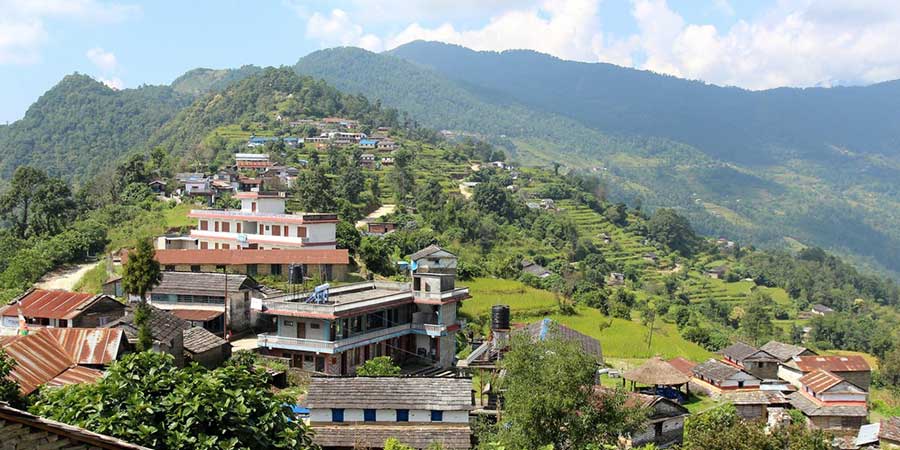

Email Us
contact@destinationhimalayatreks.com
Viber/Whats App 
+977-98510 16814 (Min Gurung)+977-98511 46814 (Tara Rana)
Sikles Trek
Trip Facts
Overview
Sikles village is located in the eastern part of the Annapurna conservation area which is one of the typical Gurung villages of Nepal. Gurung people of this village came from the western part of Tibet so Tibetan influence can be seen in their lifestyle. The Gurung people of this village are very friendly and rich in terms of their long-preserved culture, tradition, systems, customs, rituals, and festivals. Traditionally decorated homes of Gurung people in this village are the best place to stay for the trekkers. During the Sikles trek, trekkers can learn and experience the important cultural aspects of the Tibetan Gurung people by staying at their homes. Gurung people of this village organize a special entertainment singing and dancing program to give pleasure to their visitors. So, while staying in Sikles village trekkers can take part in a singing and dancing program with local Gurung people which will give them an unforgettable experience.
Besides important Gurung culture, the Sikles trek is also naturally attractive. During the Sikles trek, trekkers will get the opportunity to see several traditional villages, unbelievable scenes of beautiful landscapes, and valleys, close-up views of beautiful mountains of the region, and appealing pictures of the snake-like rivers. Sikles trek route is decorated with beautiful natural gadgets where trekkers can see the eye-pleasing and heart-taking natural scenes and scenery. The Trek route passes the colorful dense forests of rhododendron rich in different species of birds, butterflies, and wild animals. Moreover, during the Sikles trek, trekkers can see close-up views of several beautiful mountains Annapurna, Dhaulagiri, Machhapuchhre, Lamjung Himal, Nilgiri, Himchuli, Tukuche peak, and Dhampus peak.
- Typical Gurung culture, lifestyle
- Forested trails, rhododendron, and oak trees
- Beautiful traditional Gurung Village Sikles and Ghale Gaun
- Stunning views of Annapurna Ranges
- Warm hospitality of the Gurung ethnicities
- Scenic views of green hills, landscapes, and snow-capped mountains
Short Itinerary
Day 01: Drive to Pokhara (by tourist bus)
Day 02: Drive to Vijayapur Khola, trek to Kalikasthan (1370m)
Day 03: Trek to Lama Khet (1680m)
Day 04: Trek to Sikles (1980m)
Day 05: Trek Nyauli Kharka (2200m)
Day 06: Trek to Ghale Gaun (2000m)
Day 07: Trek to Hemja (1070m), drive to Pokhara
Day 08: Return to Kathmandu
Includes
- Full transportation as required for the trip
lunch,dinner and breakfast during the trek - Accommodation at tented camp
- Trekking permits and conservation permit
- All allowances for support crews and their insurance.
Excludes
- Personal bills and bar bills
- Personal trekking gears
- habitual drinks
- Tips to Nepali support crews
Detail Itinerary
-
Day 01: Drive to Pokhara (by tourist bus)
In the morning, have breakfast, and with the guide head towards Pokhara on a tourist bus. Enjoy the scenic ride and admire the views of snow-capped mountains, rivers, green hills, landscapes, and terraced fields. Arrive at Pokhara and transfer to the hotel. Later, explore the lakeside area and relish the nightlife in Pokhara. Overnight stay.
-
Day 02: Drive to Vijayapur Khola, trek to Kalikasthan (1370m)
Have breakfast and along with the guide drive towards Vijayapur Khola. From there, the trek begins where you pass through the rice fields. Keep walking witnessing the panoramic views of snow-capped mountains. Walk on an ascending trail and arrive at Kalikasthan. Overnight stay.
-
Day 03: Trek to Lama Khet (1680m)
Walk on the ascending trail traversing small villages. Appreciate the surroundings and cross Bhaise, Nawal Danda and arrive at Lama Khet. The green hills in the vicinity of Lama Khet are mesmerizing. Overnight stay.
-
Day 04: Trek to Sikles (1980m)
Walk on the easy trail along the river bank. Then, traverse Khilan Gaun and climb uphill and keep moving on a steep trail. One final ascent after traversing Parju village and reach Sikles. The oldest and largest Gurung village Sikles is very beautiful. Explore the village and get the warm hospitality of the Gurung ethnicities. Enjoy the stunning views of the Annapurna ranges, and local authentic food, and admire the lifestyle of the Gurung. Overnight stay.
-
Day 05: Trek Nyauli Kharka (2200m)
Walk on a forested trail surrounded by rhododendron and oak trees. Climb uphill and walk on a comfortable trail to reach Nyauli Kharka. Get a sight of the beautiful forest while you are at Nyauli Kharka. Overnight stay.
-
Day 06: Trek to Ghale Gaun (2000m)
Walk through the beautiful forested trail of rhododendron and traverse the high pass. Then, descend to arrive at Ghale Gaun. One of the most beautiful villages. Walk the surroundings and explore the village. Overnight stay.
-
Day 07: Trek to Hemja (1070m), drive to Pokhara
Walk on a descending trail from Ghale Gaun to Hemja. After some time, reach Hemja. Take a lunch or snack break. Then, take a public vehicle and drive to Pokhara. Overnight stay.
-
Day 08: Return to Kathmandu
Marking the end of this memorable trip, move back to Kathmandu by tourist bus. End of a fantastic journey but the memory remains forever. Overnight in a hotel.
-
Travel Info
Accommodation
Accommodations in the Sikles Treks are mostly locally owned teahouses. The teahouses are comfortable with basic facilities. The extra charge must be paid for the use of facilities like hot water buckets, laundry, charging, internet, and electricity in the teahouses.
Meals
Breakfast, Lunch, and Dinner are provided during the trekking from the teahouses. The meals are basic and suitable for the health of the trekkers. The main dish is Nepali Dal Bhat which provides enough energy throughout the trek. The variety of meals such as continental cuisines are also there but meals prepared from home-grown crops are a treat during this trek.
Drinking water
Drinking water is easily available at the teahouses. You can buy a mineral water bottle but you should do proper disposal of plastic bottles. You can also fill boiled water at teahouses paying extra charges. Always carry a water bottle and water purification medicine to prevent unwanted health issues.
Communication
The internet connectivity and phone network are fairly stable in the vicinity of Sikles. By paying extra charges at teahouses, internet facility, electricity for charging can be used. Using a local sim card, an internet facility can also be used.
Starting and Ending points
The starting point of the Sikles Trek is from Vijayapur Khola and ends in Pokhara.
"Vijayapur Khola-Kalikasthan-Lama Khet-Sikles-Nyauli Kharka-Ghale Gaun -Hemja-Pokhara"Required Permits
Annapurna Conservation Area Project (ACAP) and Trekkers Information Management System (TIMS) permits are required.
- ACAP permit cost charge: NPR 3000 (Foreigners), NPR 1000 (SAARC)
- TIMS permit cost charge: NPR 2000 (Foreigners), NPR 600 (SAARC)
Travel Insurance
Travel Insurance is very helpful and a safety net for travelers/trekkers. Travel Insurance must cover all medical emergencies, flight cancelations, emergency evacuations, loss of luggage, etc.
Safety and our guides
We assure you 100% when it comes to safety. Our client’s safety is our main concern. Our guides are certified and well-trained with years of expertise in this field. They are technically competent and have excelled in safety performance. They always carry essential safety equipment, gear, and first-aid kits. For the safety of our trekkers, the itinerary is properly scheduled and acclimatization rest days are properly set up to adjust to the high altitude and prevent altitude sickness. If any queries concerning safety, feel free to share them with our guides. We are always there for your services.
Best time for Sikles Trek
All seasons are favorable for Sikles Trek as this is a lower region trek. But, Spring and Autumn seasons are considered best because the weather is clear and sunny. Also, the trails are comfortable to walk. We recommend you plan carefully if you want to trek during the off-season (Rainy and Winter seasons).
Sikles Trek Difficulty
Sikles Trek’s difficulty is easy to a medium level difficult. The trek includes a trail having some steep ascends, descends, and rough trails. The trekker with average physical fitness and good health condition can complete the trek. It might be a little tough for new trekkers. Hence, proper preparation and guidance before starting the trek are fruitful. So, we recommend you participate in exercises, day hikes, and physical training months before starting the trek. Also, take necessary health tests before trekking to high altitudes. You can completely trust our assistance and guidelines throughout the trekking journey.
Acclimatization and Altitude Sickness
Acclimatization rest is necessary during trekking. The trek starts from Vijayapur Khola and ends at Hemja during the trek. So, in between the treks, upon reaching your daily destinations acclimatize properly. Walk to the surroundings to adapt to the environment and prevent altitude sickness.
Symptoms of Altitude Sickness
Primary: Headache, nausea, gasping, appetite & sleep loss, dizziness, fatigue, vomiting
Extreme: primary symptoms and hallucinations & unconsciousnessPreventive Guidelines
- Immediately inform the guide
- Warm-up, and body stretch before the trekking journey
- Drink water and Hydrate yourself at regular intervals
- Frequent urination throughout the journey
- Ascend slowly and gradually
- Take plenty of rest and sleep
- Avoid salty foods, alcohol, and smoking
- Descend immediately when it’s difficult/uneasy
- Take medicine consulting a guide
Shoes: Pair of hiking boots, Rubber sandals
Clothes: Windcheater jacket, Thermals, Down Jacket, Fleece, Long sleeve shirts, Gloves, Towels, Inner garments, Trekking pants, Trousers, Shorts, Socks
Accessories: Sunglasses, Hats/Caps, Beanie, Sunscreen, Lip Balm, Head Lamp, Pocket Knife, Personal Hygiene &Toiletries
Equipment: Warm Sleeping bags, Map, Trekking poles, Duffel bag
Medicine Kit: Wash Kit, First-Aid Kit, Blister Repair Kit, Medicines for preventing Altitude sickness, Prescribed Medicines (Personal use)
Rainy season: Waterproof clothes, boots, Raincoat, Anti-leech socks
Winter Season: Woolen clothing items (light)
Extras: Heat/Leak proof water bottles, Water Purifying solution (Iodine based), Water filters, Insulated cup/flask, Map, Binoculars, Travel Documents, Sewing kit, Cash, Extra batteries, Power bank, Pen, Diary, Book, Reusable (spoon, cup, plate), Reusable bags, Large Waterproof Disposable Bags, Snacks (Choco-bars, Mints, Nuts, Granola Bars)
It is best to bring the clothes and essential equipment from your home from the provided checklist. Also, you can buy or rent equipment and clothes in Kathmandu. You can customize the checklist as a necessity.
